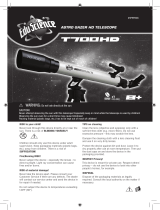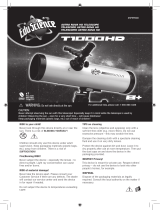Page is loading ...

1
NG114mm
114mm Newtonian Telescope w/ Equatorial Mount
Instruction Manual
AGES
10
+
WARNING:
SUN HAZARD
— Never look directly
at the sun with this device.
!
WARNING:
CHOKING HAZARD
— Small parts.
Not for children under 3 years.
!
Visit us at:
nationalgeographic.com

DISPOSAL
Dispose of the packaging materials properly,
according to their type, such as paper or
cardboard. Contact your local waste-disposal
service or environmental authority for
information on the proper disposal.
Please take the current legal regulations into
account when disposing of your device.
WARNING:
Never attempt to observe the sun with this telescope. Make sure children do not attempt to observe the sun with
the telescope. Observing the sun directly, even for a short time, may cause blindness.
Packing materials, like plastic bags, should be kept out of the reach of children.
Risk to your child!
Never look through this device directly at or near the sun. There
is a risk of BLINDING YOURSELF!
Children should only use this device under supervision. Keep
packaging materials, like plastic bags and rubber bands, out of
the reach of children, as they pose a choking hazard.
Fire and burn risk!
Never subject the device, especially the lenses, to direct
sunlight. Light ray concentration can cause fires and/or burns.
Risk of material damage!
Never take the device apart. Please consult Customer Service if
there are any defects. The dealer will contact our service center
and send the device in for repair if needed.
Do not subject the device to temperatures exceeding 140° F.
Tips on cleaning
Clean the lens (objective and eyepiece) only with a soft,
lint-free cloth, like a microfiber cloth. Do not use excessive
pressure - this may scratch the lens.
To clean a very dirty lens, dampen the cleaning cloth with
eyeglass cleaning solution, and wipe the lens gently.
Protect the device against dirt and dust. Leave it to dry properly
after use at room temperature. Then put the dust caps on and
store the device in a suitable location.
Respect privacy!
This device is meant for private use. Respect others‘ privacy.
Do not use the device to look into other people‘s homes, or
otherwise infiringe on their privacy.
Disposal
Dispose of the packaging materials as legally required.
Consult the local authority on the matter if necessary.
Customer Service:
Call 1-866-252-3811
2

How to set up:
Customer Service:
Call 1-866-252-3811
3
1) 2) 3) 4)
5)
9)
13)
=
14)
13a)
13b)
13c)
10) 11) 12)
11a) 12a)
6) 7) 8)
6a) 7a)
6b)
www.exploreone.com/pages/product-manuals

Customer Service:
Call 1-866-252-3811
4
List of parts:
Please check this list while unpacking your
telescope to ensure all parts are present:
1. Objective lens
2. Tripod
3. Flexible shaft for right ascension adjustment
4. Flexible shaft for declination adjustment
5. Telescope
6. Red dot viewfinder
7. Plossl 26 mm & 9.7 mm
8. Focuser
9. Counterweight
Technical data
Aperture: 114mm
Focal length: 500m
Magnifications
With 26 mm eyepiece: 19X
With 9.7 mm eyepiece: 52X
1
6
8
7
2
9
3
4
5
Hint:
Don’t forget to switch the red-dot
viewfinder off after use!
Cleaning and maintenance
Your telescope should, like every optical instrument, be treated with care
and stored dry. Doing so will maintain its optical performance for many
years. After using the telescope, allow any moisture or dew that has
accumulated to dry before storing the instrument inside the dust cover.
The lenses can be cleaned with a soft brush, available at photography
stores. Never use detergents, gasoline, or thinner to clean the optics!
The red-dot viewfinder is powered by a CR-2032 (3V) battery. If you need to
replace the battery, remove the old battery by pressing the holding spring
down. Make sure to insert the new battery positive-side down.

a much larger cloud of hydrogen gas and dust, which spreads out
over half of the Orion constellation. The expanse of this enormous
cloud stretches several hundred light years.
Ring Nebula (M 57)
M 57 in the Lyra constellation
Right ascension: 18:53 (Hours: Minutes)
Declination: -33:02 (Degrees: Minutes)
Distance from Earth: 2,400 light years
The famous Ring Nebula M 57 in the constellation of Lyra is often
viewed as the prototype of a planetary nebula; it is one of the
magnifi cent features of the Northern Hemisphere’s summer sky.
Recent studies have shown that it is probably comprised of a ring
(torus) of brightly shining material that surrounds the central star
(only visible with larger telescopes), and not of a gas structure
in the form of a sphere or an ellipsis. If you were to look at the
Ring Nebula from the side, it would look like the Dumbbell Nebula
(M27). When viewed from Earth, we are looking directly at the pole
of the nebula.
Dumbbell Nebula (M 27)
M 27 in the Fox constellation
Right ascension: 19:59.6 (Hours: Minutes)
Declination: -+22:43 (Degrees: Minutes)
Distance from Earth: 1,360 light years
The Dumbbell Nebula (M 27) in Fox was the fi rst planetary nebula
ever discovered. On July 12, 1764, Charles Messier discovered this
new and fascinating class of objects. We see this nebula almost
directly from its equatorial plane. If we could see the Dumbbell
Nebula from one of its poles, we would see the shape of a ring,
and we would see something very similar to what we know as the
Ring Nebula (M 57). In reasonably good weather, we can see this
object well even with low magnifi cations.
Possible objects for observation:
The following section details several interesting and easy-to-fi nd
celestial objects you may want to observe through your telescope. The
pictures at the end of the manual show what the objects will look like
through your telescope’s eyepiece.
Terrestrial objects
Take note of the examples below, including Mount Rushmore and the
golf course. Start with the 26 mm eyepiece and focus until the image
is clear. After mastering the 26 mm eyepiece, switch to the 9.7 mm
eyepiece and practice scanning and focusing until the image is clear.
Choose several terrestrial objects to practice focusing on, but never
point your telescope at or near the sun, or you risk blindness.
The Moon
The moon is the Earth’s only natural satellite.
Diameter: 3.476km
Distance from Earth: approx. 384,400 km (average)
The moon has been known to humans since prehistoric times. It is the
second brightest object in the sky (after the sun). Because the moon
circles the Earth once per month, the angle between the Earth, the
moon and the sun is constantly changing; one sees this change in the
phases of the moon. The time between two consecutive new moon
phases is about 29.5 days (709 hours).
Orion Nebula (M 42)
M 42 in the Orion constellation
Right ascension: 05:35 (Hours: Minutes)
Declination: -5:22 (Degrees: Minutes)
Distance from Earth: 1,500 light years
Located about 1,500 light years from Earth, the Orion Nebula (Messier
42, abbreviation: M 42) is the brightest diffuse nebula in the sky –
visible with the naked eye, and a worthwhile object for telescopes of all
types and sizes, from the smallest fi eld glass to the largest earthbound
observatories and the Hubble Space Telescope.
When talking about Orion, we‘re actually referring to the main part of
f=26 mm f=9.7 mm
The Moon
Orion Nebula (M 42)
Ring Nebula in Lyra
constellation (M 57)
Dumbbell Nebula in the
Vulpecula (Fox)
constellation (M 27)
f=26 mm f=9.7 mm
Terrestrial Images
Celestial Images
Customer Service:
Call 1-866-252-3811
5

Viewing object visible Align finder to telescope
in the nder, but not
through the telescope
Despite using star The star diagonal prism
diagonal prism should be vertical in
the picture is “crooked” the eyepiece connection.
Telescope ABC’s
What do the following terms mean?
Diagonal:
A mirror that deflects rays of light 90 degrees. With a horizontal
telescope tube, this device deflects the light upwards so that you can
comfortably observe by looking downwards into the eyepiece. The
image in a diagonal mirror appears upright, but rotated around its
vertical axis (mirror image).
Focal Length:
Everything that magnifies an object via an optic lens has a certain focal
length (FL). The FL is the length of the path the light travels from the
surface of the lens to its focal point. The focal point is also referred to
as the focus. In focus, the image is clear. In a telescope, the FL of the
telescope tube and the eyepieces are combined.
Lens:
The lens turns the light which falls on it around in such a way so that
the light gives a clear image in the focal point after it has traveled a
certain distance (focal length).
Eyepiece:
An eyepiece is a system made for your eye and comprised of one or
more lenses. In an eyepiece, the clear image that is generated in the
focal point of a lens is captured and magnified even more.
There is a simple formula for calculating the magnification:
focal length of the telescope tube / focal length of the eyepiece =
magnification
In a telescope, the magnification depends on both the focal length of
the telescope tube and the focal length of the eyepiece.
Magnication:
The magnification corresponds to the difference between observation
with the naked eye and observation through a magnification apparatus
such as a telescope. In this formula, observation with the eye is
considered “single,” or 1x magnification. Accordingly, if a telescope
has a magnification of 30x, then an object viewed through the
telescope will appear 30 times larger than it would with the naked eye.
Troubleshooting:
Problem: Solution:
No picture Remove dust protection cap and
sun-shield from the objective
opening.
Blurred picture Adjust focus using focus ring.
No focus possible Wait for temperature to
balance out.
Bad quality Never observe through a
glass surface such as a window.
DISPOSAL
Dispose of the packaging materials properly,
according to their type (paper, cardboard, etc).
Contact your local waste disposal service or
environmental authority for information on the
proper disposal.
(see instructions).
The Red Dot Viewfinder is
powered by a battery type
CR-2032 (3V); if a replacement is
necessary, remove cap (Fig. 1) by
unscrewing set screw (Fig. 2) and
sliding battery towards the front.
Slide new battery in place with the
positive (+) side showing. Replace
cap and tighten with
set screw (Fig. 2).
Fig. 1
Fig. 2
Front
Red Dot Viewfinder
(bottom view)
El Visor Red Dot es
impulsado por un tipo de batería
CR-2032 (3V); si un reemplazo es
necesario, retire la tapa (fig. 1),
desenroscando el tornillo de ajuste
(fig. 2) y la batería de deslizamiento
hacia la parte delantera. Deslice la
pila en el lugar con la positiva
proyección lateral (+). Reemplace
la tapa y apriete con
el tornillo de
fijación (fig. 2).
fig. 1
fig. 2
frente
Red Dot visor
(vista desde abajo)
English
Le Dot Viseur rouge est
alimenté par une batterie de type
CR-2032 (3V), si un remplacement
est nécessaire, enlever le bouchon
(Fig. 1) en dévissant la vis de
réglage (Fig. 2) et la batterie de
glissement vers l'avant. Glisser la
nouvelle pile en place avec la
borne positive (+) côté montrant.
Remettre le bouchon et
le serrer avec
la vis de
pression
(Fig. 2).
Fig. 1
Fig. 2
de devant
Red Dot Viseur
(vue de dessous)
FrenchSpanish

Notes

© 2017 Explore Scientific®, LLC.
1010 S 48th St. Springdale, AR 72762
explorescientificusa.com | exploreone.com | 866.252.3811
All rights reserved. Made in China.
CONFORMS TO THE SAFETY
REQUIREMENTS OF ASTM F963
© 2017 National Geographic Partners LLC.
All rights reserved. NATIONAL GEOGRAPHIC
and Yellow Border Design are trademarks of the
National Geographic Society, used under license.
8
Visit us at:
nationalgeographic.com
/



